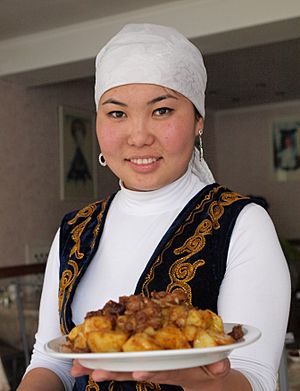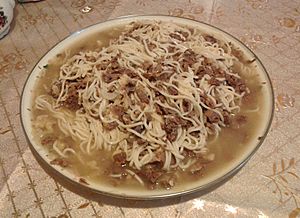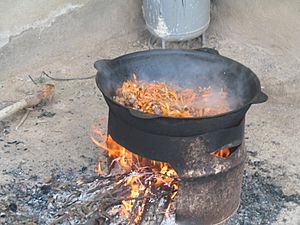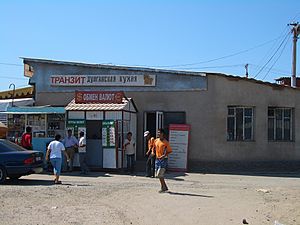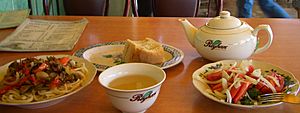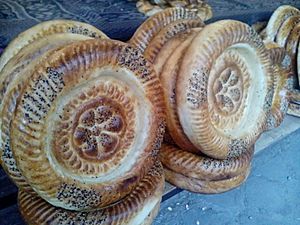Kyrgyz cuisine facts for kids
Kyrgyz cuisine is the traditional food of the Kyrgyz people, who make up most of the population in Kyrgyzstan. Their food is quite similar to what their neighbors eat.
Traditional Kyrgyz meals often feature mutton (lamb), beef, and even horse meat. They also use many different dairy products. The way food is prepared and the main ingredients used have been greatly shaped by the Kyrgyz people's history as nomads, meaning they moved around a lot. This is why many cooking methods help keep food fresh for a long time. Mutton and beef are favorite meats, but today, not everyone can afford them regularly.
Kyrgyzstan is home to many different groups of people, and each has its own special foods. In bigger cities like Bishkek, Osh, Jalal-Abad, and Karakol, you can find many kinds of local and international dishes. Some popular foods from other cultures in Kyrgyzstan include Uyghur, Dungan, Uzbek, and Turkish foods. These represent some of the largest minority groups in the country.
Contents
Delicious Meat Dishes
Meat has always been a very important part of Kyrgyz cooking. Here are some of the most popular meat dishes:
- Kazy or Chuchuk: These are sausages made from horse meat.
- Roasted sheep's liver: A tasty dish made from sheep's liver.
- Beshbarmak: This dish has boiled, shredded meat served with thin noodles.
- Other special foods made from horse meat.
Beshbarmak: The National Dish
Beshbarmak is known as the national dish of Kyrgyzstan. It's also popular in Kazakhstan and in a region called Xinjiang (where it's called narin). This dish is made by boiling horse meat (or mutton/beef) in its own broth for several hours. Then, it's served over homemade noodles and sprinkled with fresh parsley.
The name Beshbarmak means "Five Fingers" in the Kyrgyz language. It's called this because people traditionally eat the dish with their hands. Beshbarmak is often made for special celebrations. These include welcoming a new baby, celebrating an important birthday, or remembering someone who has passed away, like at a funeral or on an anniversary. If mutton is used instead of horse meat, a boiled sheep's head might be placed on the table. The most honored guest then cuts pieces from the head and shares them with everyone else.
Dimlama: A Hearty Stew
Dimlama is a warm and comforting stew. It's made with meat, potatoes, onions, and other vegetables. Sometimes, fruits are even added to it!
Kuurdak: A Main Meat Meal
Kuurdak is another important meat dish in Kyrgyz cuisine. It's often one of the main courses served.
Shashlik: Grilled Skewers
Shashlik consists of chunks of mutton meat grilled on skewers over hot coals. It's usually served with raw sliced onions. You can find shashlik in restaurants and often sold by street vendors. The meat is usually soaked in a special sauce (marinated) for many hours before it's cooked. Shashlik can also be made with beef, chicken, or fish. Each skewer often has an equal amount of fat and meat.
Shorpo: A Warm Meat Soup
Shorpo (or sorpo) is a traditional meat soup. It's a comforting dish, especially on colder days.
Laghman: Noodles with Flavor
Laghman is a popular dish that includes meat, vegetables, and special pulled noodles. It's known for its rich flavors.
Paloo: A Delicious Rice Dish
Paloo is the Kyrgyz version of a dish known as plov in Central Asian cuisine. It's made by frying pieces of meat (usually mutton or beef, but sometimes chicken) in a large qazan. A qazan is a big, cast-iron pot. Shredded carrots and jiucai (garlic chives) are mixed in and fried too. Then, rice is added and cooked with everything. The dish is often decorated with whole fried garlic cloves and hot red peppers.
Uzgen paloo is a special type made with rice grown in the southern Uzgen District of Kyrgyzstan. Shirin paloo is a vegetarian version. Instead of meat, it uses dried fruits like prunes, apricots, and raisins. This dish is similar to shirin plov from Azerbaijani cooking.
The word Paloo comes from the Persian word polow or polo, which is related to pilaf. In Russian, it's called plov. In Turkish, it's pilav, and in Turkic languages, it's often called ash.
Noodles and Dumplings
- Manty: These are steamed dumplings filled with ground meat and onions. They are a very common and loved dish.
- Samsa: Samsa are small pockets of flaky pastry or bread filled with meat and vegetables. They are very similar to Indian samosas. Most often, they are stuffed with mutton and fat. But you can also find them with chicken, cheese, cabbage, beef, and even pumpkin. You can buy them in most markets (bazaars) or from street vendors in bigger cities.
- Lagman: Lagman (or laghman) is a very popular noodle dish. It uses thick noodles made by stretching a simple flour dough. These noodles are then covered in chopped peppers and other vegetables and served in a spicy, vinegary sauce. Lagman is served everywhere in Kyrgyzstan, but it's considered a Dungan or Uyghur dish.
Bread and Tea
Common types of bread (called nan in Kyrgyz) in Kyrgyzstan include Central Asian flat bread and thick, sturdy Turkish breads. The Central Asian flat bread is cooked over hot coals in special tandoori ovens. It's round and relatively flat.
More traditional bread products include qattama and boorsoq, which are both types of fried bread.
Kyrgyz people often eat different breads by dipping them in jam, kaymak (a thick cream), butter (or sary may), and other spreads. Boorsoq is sometimes eaten floating in tea or dipped in honey.
Bread is considered very special and sacred in Kyrgyz culture. A good host will always offer a guest bread, usually with tea, even if the guest is only visiting for a short time.
Refreshing Beverages
A very popular Kyrgyz drink is kymyz. This is a slightly alcoholic drink made by fermenting mare's (female horse) milk. It's seen as the signature drink of nomadic cultures in Eurasia, as it's also enjoyed in Kazakhstan and Mongolia. Fresh kymyz is only available in the summer, from about May to August. During this time, you can often buy it by the roadside in mountain areas. Bottled kymyz is also sold year-round in most food shops across the country.
There are many other traditional Kyrgyz drinks. One popular non-alcoholic drink, especially in the summer, is maksym. This is a slightly fizzy drink made by fermenting grains. Maksym was traditionally made in small amounts by women for their families. However, a company called 'Shoro' started selling it commercially in Bishkek, and now it's widely available throughout Kyrgyzstan. Maksym is usually made from malt, but other types of grains can be used. There are different ways to make it, and recipes vary by region. It's prepared by boiling ground malt or other cereals in water. After cooking, it's cooled and then fermented using yeast. Maksym is usually served chilled.
Jarma is a similar drink made from ground cereals. It's prepared almost like maksym, but it's not fermented. Instead, it's mixed with ayran (a yogurt drink) to make it slightly fizzy.
Another fizzy drink made from ayran is chalap (sometimes sold as Tan). Other traditional drinks include sheep's milk and its products like qurut (dried yogurt balls), and camel's milk. The two main companies that make Kyrgyz national drinks for sale are Shoro and Enesay.
Bozo is a slightly alcoholic drink made from wheat.


